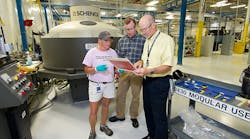“Manufacturing is a full-contact sport,” says Michael Papp, general manager of Pratt & Whitney’s North Berwick Parts Center in Maine. To get on the field and play in aerospace, he explains, you need “spotless” quality, ethics and safety, not to mention “perfect” delivery. But that’s just the beginning. “You only win by being cost-competitive,” says Papp.
Pratt & Whitney assigns work to its facilities based on competitive bidding. If an outside supplier offers a better price for quality work, it wins the job. When Papp came to the plant eight years ago, he encountered an attitude that he knew had to change.
“We were acting like someone was going to give us work,” he recalls. In his first six months, 200 people were laid off and funding was tight.
Papp met with his senior leadership team and charted a more entrepreneurial course. One of the first steps was to promote product development at the facility. If North Berwick is involved in designing a part, it provides “a leg up” when it comes time to bid for manufacturing it, he says.
Kevin McDonnell, manager of the engineering center, says having designers and manufacturing engineers working together on a daily basis results in a collaborative design process that is faster and smoother. ”We have far fewer turnbacks and we’re not cycling back and forth,” he said.
Pratt & Whitney North Berwick Parts CenterNorth Berwick, Maine Employees: 1,430, non-union Total Square Footage: 1,000,000 Primary Product/Market: Jet engine components Start-up Date: 1979 Achievements: OSHA VPP site since 1998; 20% reduction in in-plant defect rate in past 3 years; 35% of plant’s production is represented by new or redesigned products introduced in previous 12 months |
Plant leaders took a variety of other steps, including partnering with outside suppliers on work, developing proprietary coatings for aircraft parts, enhancing the plant’s proficiency in machining and bringing in modular assembly work. They also aggressively pursued work on new products, including Pratt’s next generation Geared Turbofan engine for commercial aircraft and the engine for the Lightning II fighter jet.
Once facing potential closure, the huge plant (nearly 20 acres under roof and a growing workforce of more than 1,400) has become a jewel in the Pratt & Whitney family and the object of a massive transformation to make it ready for production of parts and modules for the new generation engines. The company has spent more than $150 million on capital investments and new technology. Over the past three years, Pratt has renovated over 100,000 square feet of floor, roof and ceiling, and completed 175 continuous improvement events.
The company has also introduced its overhead-automated horizontal moving assembly lines for engine module builds. Five years ago, the plant had 10 people working on modular assembly. This year, it will have nearly 200 working on assembling sections of jet engines. Through these investments, Pratt expects to reduce assembly time by 50% while also improving job ergonomics for assembly technicians.
The North Berwick plant produces approximately 1,200 parts for jet engines, with 45% of its production for the commercial market and another 45% for military engine parts. Manufacturing processes include everything from milling and grinding to heat treat and specialized thermal and plasma spray coatings. Papp emphasized the exacting nature of the machining and assembly work going on in the plant.
For the manufacturing operations, he noted, machine programming ensures consistency. “On the assembly side, it is the operator. There is no program. It is them doing that consistently time after time after time,” he says.
While most of the plant’s work involves manufacturing OEM parts, it also has a sizable repair business which accounts for about 10% of production. Papp noted that while the plant has little contact with end customers on the OEM side, it deals directly with customers such as GE and Rolls Royce through its aftermarket work and that direct feedback is valuable to the entire operation.
While Papp and his team follow lean manufacturing principles designed to improve the plant every day, they hope the plant’s transformation forms a foundation for a longer horizon.
“Our mission, more than anything else, is to pass this plant on to the next generation,” he states.



